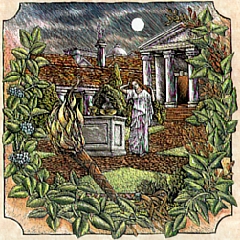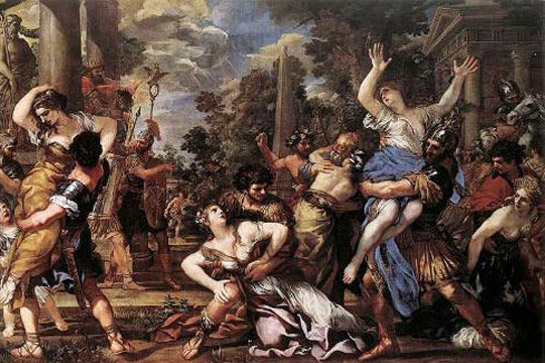![]()
 Wiccan
Lore
Wiccan
Lore
In many Wiccan traditions, Imbolc is celebrated as the point in the year when the Goddess recovers from giving Birth to the Sun. The young God grows from an infant to a child. It is a time when the growing light promises the return of springtime. Many Wiccans also tend to focus their rituals on the Maiden aspect of the goddess at this time as well.
![]()
Celtic Lore
The goddess, Brighid, is primarily worshiped because of her triple aspect as the patroness of smith-craft (fire associations), healing, and inspiration.
![]()
Imbolc Correspondences
- Other Names: Imbolg, Oimelc, Candlemas, Feast of Brigid, Festival of Lights, Feast of Flames, Candlelaria, La Feill Bhride.
- Colors: White, Pink, Red, and Blue
- Symbols: Candles, the Bride, Burrowing Animals, Grain Dolly, Sun Wheels
- Ritual Meaning: Honor of the Virgin Goddess, First Signs of returning life, and the Festival of Light
- Key Action: Open and Begin
- Ritual Oils: Jasmine, Apricot, Carnation, Sweet Pea, Neroli and Olive.
- Stones: Amethyst, Bloodstone, Garnet, Ruby, Onyx, and Turquoise.
- Plants: Angelica, Basil, Bay Laurel, Blackberry, Celandine, Coltsfoot, Heather, Iris, Myrrh, Tansy, Violets, and all white or yellow flowers
- Activities: Candle lighting, Searching for Signs of Spring, Gathering Stones
- Taboos: Cutting or Picking Plants.
- Animals: Wolf, Snake, Swan, Vulture, Robin, Burrowing Animals, Sheep, Lamb, and Deer
- Mythical Creatures: Firebird, Dragon, Berometz
- Deities: Aradia, Arachne, Arianrhod, Athena, Brighid, Blaize, Branwen, Februa, Gaea, Inanna, Lucina, Vesta, Cupid/Eros, Diancecht, Dumuzi, and Februus
- Foods: Pumpkin seeds, Sunflower seeds, Poppyseed Cakes, muffins, scones, and breads, all dairy products, Peppers, Onions, Garlic, and Raisins.
- Drinks: Milk, Spiced Wines and Herbal Teas.
![]()
Brighid's Day
 Imbolc
is also called "Brigit's Day", in honor of the great Irish Goddess Brigit.
At her shrine, the ancient Irish capital of Kildare, a group of 19
priestesses (no men allowed) kept a perpetual flame burning in her honor.
Imbolc
is also called "Brigit's Day", in honor of the great Irish Goddess Brigit.
At her shrine, the ancient Irish capital of Kildare, a group of 19
priestesses (no men allowed) kept a perpetual flame burning in her honor.
She was considered a goddess of fire, the patroness of smithcraft, poetry and healing (especially the healing touch of midwifery). This tripartite symbolism was occasionally expressed by saying that Brigit had two sisters, also named Brigit. Another form of the name Brigit is Bride, and it is thus She bestows her special patronage on any woman about to be married or handfasted, the woman being called "bride" in her honor.
The Roman Catholic Church could not very easily call the Great Goddess of Ireland a demon, so they canonized her instead. Henceforth, she would be "Saint" Brigit, patron saint of smithcraft, poetry, and healing.
Brigit's holiday was chiefly marked by the kindling of sacred fires, since she symbolized the fire of birth and healing, the fire of the forge, and the fire of poetic inspiration. Bonfires were lighted on the beacon tors, and chandlers celebrated their special holiday. The Roman Church was quick to confiscate this symbolism as well, using "Candlemas" as the day to bless all the church candles that would be used for the coming liturgical year.
The Catholic Church, never one to refrain from piling holiday upon holiday, also called it the Feast of the Purification of the Blessed Virgin Mary. It is surprising how many of the old Pagan holidays were converted to Mary Feasts. The symbol of the Purification may seem a little obscure to modern readers, but it has to do with the old custom of "churching women". It was believed that women were impure for six weeks after giving birth. And since Mary gave birth at the winter solstice, she wouldn't be purified until February 2nd. In Pagan symbolism, this might be re-translated as when the Great Mother once again becomes the Young Maiden Goddess
![]()
Lupercalia
 A
curious Imbolc festival of purification known as Lupercalia was overseen by
a class of priests known as the Luperci. Here rites of purification and
symbolic fertility were interwoven. The Luperci took strips of goat skin and
raced in the nude from the legendary grotto where Romulus and Remus were
suckled by a wolf and along the Via Sacra, laying the lash across the backs
or buttocks of any women they encountered in passing, thus assuring them
fertility.
A
curious Imbolc festival of purification known as Lupercalia was overseen by
a class of priests known as the Luperci. Here rites of purification and
symbolic fertility were interwoven. The Luperci took strips of goat skin and
raced in the nude from the legendary grotto where Romulus and Remus were
suckled by a wolf and along the Via Sacra, laying the lash across the backs
or buttocks of any women they encountered in passing, thus assuring them
fertility.
There are two legends explaining the origins of this rite. The first recounts that Romulus and Remus, after the victory over Amulio, removed their encumbering clothing and raced each other exultant to the site where the she-wolf had suckled them as children.
The second legend states that after the rape of the Sabine women, the raped wives were left sterile. The men and women then went to pray for a cure in a forest consecrated to Juno. Her voice sounded in the rustling leaves, replying that the Sabine wives must be joined with a sacred goat.
Everyone was dismayed at the thought of such a joining. An Etruscan soothsayer solved the dilemma by sacrificing a goat to Juno and making leather straps from its skin. He ordered the young wives to offer themselves to the penetrating blows of the straps. The women complied with the dictates of the goddess and thereby overcame the infertility curse.
![]()
Candlemas
Many Wiccans call Imbolc by the name Candlemas. Candlemas involves celebrations of banishing the winter and welcoming the spring. At the time of Candlemas, the new-born Sun God is seen as a small child nursing from his Mother. At this phase of the cycle, winter is swept away and new beginnings are nurtured.
In the seventh century, the Roman Church adopted a celebration known as the Festival of St. Simon. The date was changed to February 2 in hopes of putting an end to the rival Pagan celebrations.
February 2 became the Purification of the Blessed Virgin. This time was then known as Candelora or Candlemas because people were blessed by candles distributed to the faithful by the Church. These candles were believed to possess protective virtues against calamities, storms, and the agony of death.
![]()
Brideo'gas
The Maiden is honored, as the Bride, on this Sabbat. Straw Brideo'gas (corn dollies) are created from oat or wheat straw and placed in baskets with white flower bedding. Young girls then carry the Brideo'gas door to door, and gifts are bestowed upon the image from each household. Afterwards at the traditional feast, the older women make special acorn wands for the dollies to hold, and in the morning the ashes in the hearth are examined to see if the magic wands left marks as a good omen.
![]()
Groundhog Day
 In
America, Groundhog's Day is celebrated on February 2nd. Groundhog's Day is
basically a weather divination ritual. If the day is sunny, the Groundhog
will see his shadow and for some reason be frightened by it, returning to
his hole to sleep for 6 more weeks until the Spring Equinox, as we endure an
extended winter. If it's cloudy, however, he won't receive the fright and we
are due for an early spring.
In
America, Groundhog's Day is celebrated on February 2nd. Groundhog's Day is
basically a weather divination ritual. If the day is sunny, the Groundhog
will see his shadow and for some reason be frightened by it, returning to
his hole to sleep for 6 more weeks until the Spring Equinox, as we endure an
extended winter. If it's cloudy, however, he won't receive the fright and we
are due for an early spring.
European folklore attributes this weather-forecasting ability to not only the groundhog, but the bear and the badger, too. And a similar tradition -- where snow and overcast skies signal an early end to winter -- is observed in northern Europe on Candlemas Day, which also falls on February 2 and in some areas marks the beginning of spring planting.
This custom is ancient. An old British rhyme tells us that "If Candlemas Day be bright and clear, there'll be two winters in the year."
Actually, all of the cross-quarter days can be used as "inverse" weather predictors, whereas the quarter- days are used as "direct" weather predictors.
![]()
Goddess Februa
In ancient Rome, February was a period of passage signaling the end of the old year ear and the prelude of the birth of the new year. February was sacred to the Roman goddess Februa and her consort Februus, who were deities of purification and death. February focused upon expiation of the souls of the dead, as well as personal, spiritual, and physical.
At the Calenda of February one celebrated the dedication of her temple on the Palatine Hill with a procession of torches. By the seventh century, Rome created a Christian festival of night time processions with candles from every parish, intended as a penitential procession to exorcise a resurgent licentious and carnal Pagan parade.
On Imbolg night, it is also said that the spirits of the dead walk among the living. The connection of the dead and themes of death within the Roman celebration of February never disappeared, even in the distant conquered territories of the Roman Empire. The Full Moon following this month begins the time of self purification known as Lent. This is a remnant of the old rites of February.
For modern Witches, candles can be anointed with a scented oil. Sit in front of the candle and meditate on what is both desirable and undesirable in your life and in your heart. Affirm that you will nurture the good and dissuade the bad.
![]()